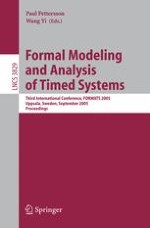2005 | Buch
Formal Modeling and Analysis of Timed Systems
Third International Conference, FORMATS 2005, Uppsala, Sweden, September 26-28, 2005. Proceedings
herausgegeben von: Paul Pettersson, Wang Yi
Verlag: Springer Berlin Heidelberg
Buchreihe : Lecture Notes in Computer Science
